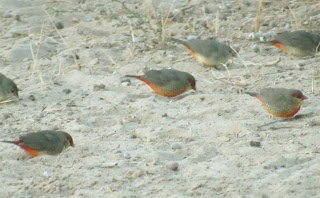I was very wrong. Mohamed Vall and I saw 114 species that day. Furthermore, five were additions to my country list taking it up to 291.
Things started quite slowly. We elected to bird straight out of the lodge in the morning and that took us into woodland.
African wattled lapwing
An early bird was African wattled lapwing. It wasn't new for me but it was for Mohamed. It was barely light so views weren't the best.
zebra waxbill
Also in the early light, a flock of zebra waxbill were observed.
Western red-billed hornbill
striped kingfisher
Striped kingfisher proved every bit as common as our fast encounter with two the evening before had suggested.
goat up a tree
As a diversion from birding for a couple of minutes, we were amused by a goat eating from the top of a tree.
black-billed wood dove
Black-billed wood dove is only found in the very south of the country and then only in fairly densely wooded areas. However, it quite common in one patch of the woodland walk.
Once again, I failed to find a village weaver among the various weavers in the woodland.
After more than half the morning in the woodland near the lodge, we ventured westwards towards the sea on foot. The terrain soon turned into salty semi-desert. Our best bird out of the very few there was a cream-coloured courser.
Retruning to the lodge and then into the car we drove south west towards the border crossing with Senegal at Diama. We didn't get very far before deciding to bird one or two spots just off the road.
northern ant-eater chat
New birds for the day came thick and fast. They included northern ant-eater chat and little bee-eater.
little bee-eater
I also spotted a wryneck.In another place further down the road, we accidentally flushed three Long-tailed nightjar.
Long-tailed nightjar
You can't really go out looking for nightjars in daylight so this was a lucky find. It was also the first of five new birds on my Mauritanian list that day.
Thanks are due to Fretback in near-by Senegal for alerting me to my original but wrong identification as Eurasian nightjar. In my defence the distribution map in the first edition of Birds of Western Africa shows Eurasian nightjar as an isolated northern place for wintering Eurasian nightjar while long-tailed nightjar all move well south. It appears that both pieces of information are untrue. Some long-tailed nightjar stay in the Senegal River Delta area while all Eurasian nightjar are well south in winter. The moral is to identify first and trust judgement against maps.
As Fretback also pointed out this bird was resting on the ground which Eurasian nightjar seldom do.
We arrived at Lake Biretta. This is the last lake before the border bridge over the Senegal River at Diama.
some white-faced whistling duck
The best sighting here was over 500 white-faced whistling duck on the lakeside. We were hampered from birding an attractive looking grass field by surrounding marsh. I still wonder what birds that different habitat might have held.
After a quick lunch, we made a decision to go back east to Bell Basin, which we had visited the day before with Abdullah. It turned out to have been the right decision.
African skimmer with Caspian tern
New birds came quickly once again. Looking way out into some of the open water, we spotted three African skimmer on a small sandbank.
African pygmy goose
In water between the two fishing hamlets, we found a small group of African pygmy goose.
At the second hamlet we finally made a positive identification of a yellow-billed stork though we failed to get a photo. The stork, goose and skimmer were all new to my country list.
African stonechat
We headed north east towards the grassland areas we had briefly noticed the day before. African stonechat was once again common in the tamarisk we passed.
Warthogs are a frequent sighting in the park but most don't hold their ground on the road like this brave one. It waited for its partner who got separated from it when we drove by.
warthog
I wish we had had time to search the grassland more thoroughly. However, time was not on our side.
black crowned crane
Nevertheless two black crowned crane were too obvious to miss despite the distance between us and the crown acting as clever camouflage. This was the final addition to the list of the day.
It was not the end of the birding though as we turned off west towards the village of la dune de Ziré.
A yellow-billed stork provided the picture of the species we failed to get earlier.
yellow-billed stork
The scattered woodland in the dunes gave us the only blue-eared glossy starling and green-backed camaroptera of the trip within Diawling.
green-backed camaroptera
Turning back from the village towards the lodge, it was a race to get as far as possible before nightfall.
adult African fish eagle
We stopped just once to get good views of an adult African fish eagle.
It had been a very successful day. The next day, New Year's Day was not an anti-climax. I will blog about that next.



















Bien chagriné pour votre liste, mais votre photo d'engoulevent est celle d'un caprimulgus climacurus climacurus (long-tailed nightjar, la longueur de la terminaison nous le prouve)... L'espèce est commune dans notre région bas-deltaïque et a pour habitude de reposer au sol dans la journée (tas de branchages morts en particulier) à la différence de l'engoulevent européen qui préfère les branches basses. Et ne stationne pas en hiver sous nos latitudes. Nous suivons depuis le Sénégal avec un vif intérêt vos nombreuses coches mauritaniennes. Bravo et merci à vous (et à Mohamed Vall). F.B. pour Ornithondar.
ReplyDeleteLovely bird.
ReplyDeletehttp://grsshoes.com/
Birding for a Lark shares tips and experiences for birdwatching enthusiasts, featuring stunning images and observations. During photosweek , readers can explore these visuals to learn more about bird species and photography techniques.
ReplyDelete